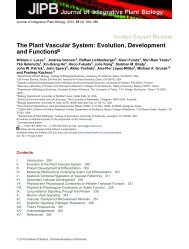New species of Solanum and Capsicum (Solanaceae) from Bolivia ...
New species of Solanum and Capsicum (Solanaceae) from Bolivia ...
New species of Solanum and Capsicum (Solanaceae) from Bolivia ...
You also want an ePaper? Increase the reach of your titles
YUMPU automatically turns print PDFs into web optimized ePapers that Google loves.
2006] nee et al.: solanum <strong>and</strong> capsicum (solanaceae) 335<br />
dividuals in dense cloud forests, unlike many<br />
<strong>of</strong> the other members <strong>of</strong> the S. nudum <strong>species</strong><br />
group that are plants <strong>of</strong> open areas along<br />
streams <strong>and</strong> roads.<br />
The Wendl<strong>and</strong>ii/Allophyllum clade<br />
<strong>Solanum</strong> cl<strong>and</strong>estinum Bohs, sp. nov.<br />
Type: <strong>Bolivia</strong>. La Paz. Prov. Nor Yungas: 2<br />
km by road (ca. 1 km by air) NE <strong>and</strong><br />
below Chuspipata, 16°17'30"S, 67°49'W,<br />
2950 m, 29 Oct 1984 (fl, fr), M. Nee & J.<br />
Solomon 30219 (holotype: LPB;<br />
isotype: MO). (Fig. 6)<br />
Habitu, foliis et fructibus S. confuso C. V. Morton<br />
similis sed pedunculis brevissimis, antheris obtusis oblongis<br />
et seminibus rotundatis differt.<br />
Slender shrub 1–2.5 m tall; stems glabrous<br />
to densely pubescent with unbranched hairs,<br />
some with broad multiseriate bases giving<br />
the young stems a corky or roughened appearance,<br />
unarmed. Sympodial units difoliate,<br />
geminate. Leaves 3–12 × 0.5–3 cm,<br />
simple, dimorphic, the major leaves 5–12 ×<br />
1–3 cm, narrowly elliptic to lanceolate, the<br />
minor leaves 3–4 × 0.5–1 cm, differing <strong>from</strong><br />
the major ones only in size, usually subcoriaceous,<br />
glabrous adaxially, glabrous to moderately<br />
pubescent abaxially with unbranched<br />
hairs; base cuneate to long-tapered; margin<br />
entire, glabrous to ciliate; apex acute to<br />
acuminate; petioles 0.5–2 cm, 1–2 cm in<br />
major leaves, ca. 0.5 cm in minor leaves,<br />
glabrous to moderately pubescent in adaxial<br />
channel. Inflorescence 0.5–2 cm, opposite the<br />
leaves, unbranched or rarely forked, with 1–6<br />
flowers, all flowers perfect, the axes glabrous<br />
to sparsely pubescent; peduncle 0.2–2 cm;<br />
rachis very short, 1–4 mm; pedicels 10–20<br />
mm in flower, 15–35 mm <strong>and</strong> slender <strong>and</strong><br />
curved in fruit, congested <strong>and</strong> spaced up to 3<br />
mm apart, articulated at the base. Calyx 2–3<br />
mm long, the tube ca. 1 mm, the lobes 1–2 ×<br />
1.5–2 mm, broadly deltate, almost truncate<br />
with a small acumen at tip, glabrous at base,<br />
tomentose at tips; fruiting calyx not accrescent,<br />
the lobes 1–2 × 1.5–2 mm; corolla 1–<br />
1.5 cm in diameter, 4–7 mm long, stellate,<br />
white, the tube 1–2 mm, the lobes 3–5 × 2–<br />
2.5 mm at base, narrowly triangular to ovate,<br />
acute at apices, glabrous abaxially at base,<br />
tomentose at tips <strong>of</strong> lobes, glabrous adaxially;<br />
filaments glabrous, the free portion 0.5–<br />
1 mm, the filament tube absent to 0.5 mm;<br />
anthers 3–4 × 1.5–2 mm, oblong, connivent,<br />
yellow, the pores broad, directed distally <strong>and</strong><br />
adaxially, <strong>of</strong>ten opening into longitudinal<br />
slits with age; ovary glabrous; style 4–5 × ca.<br />
0.5 mm, cylindrical, straight; glabrous;<br />
stigma truncate. Fruit a globose berry, 1–1.5<br />
cm in diameter, orange when ripe, glabrous.<br />
Seeds fewer than 15 per fruit, ca. 4 × 3 mm,<br />
somewhat flattened, yellow-brown, the surfaces<br />
rugulose.<br />
Distribution <strong>and</strong> ecology.—Montane rain<br />
<strong>and</strong> cloud forest, especially on slopes or in<br />
disturbed areas, <strong>of</strong> western <strong>Bolivia</strong> in Yungas<br />
de La Paz, 2200–3100 m.<br />
Phenology.—Flowering specimens have<br />
been collected in May, June, <strong>and</strong> August<br />
through October. Fruiting specimens have<br />
been collected in March, May, June, August,<br />
<strong>and</strong> October.<br />
Etymology.—The specific epithet, meaning<br />
“hidden,” refers to the inconspicuous appearance<br />
<strong>of</strong> this <strong>species</strong>, which has probably led<br />
to it being overlooked until now. On a recent<br />
<strong>Bolivia</strong>n field trip, three <strong>Solanum</strong> specialists<br />
ate lunch next to the plants without noticing<br />
them at first, despite the botanists’ interest in<br />
collecting this <strong>species</strong>. When one plant was<br />
finally recognized, several others were found<br />
in close proximity.<br />
Additional specimens examined: BOLIVIA. La Paz.<br />
Prov. Nor Yungas: Guanai, 1891 (fr), Bang s.n. (NY);<br />
Yolosa, 23 km hacia Chuspipata, 2730 m, 16 Sept 1981<br />
(fl), Beck 4844 (NY); road <strong>from</strong> Coroico to divide leading<br />
to La Paz, 21 May 1980 (fl, fr), D’Arcy & Bejarano<br />
13875 (NY); road <strong>from</strong> Chuspipata to Yolosa, ca.<br />
68°00'W, 16°20'S, 2000–2700 m, km 20–13, 4/11/1989<br />
(fr), J. F. Smith & Beck 1731 (LPB, NY); 2.2 km NE<br />
(below) Chuspipata, 16°17'S, 67°49'W, 3000 m, 24 Mar<br />
1982 (fr), Solomon 7296 (MO, NY); 1.6 km NW <strong>of</strong><br />
Chuspipata, 16°18'S, 67°49'W, 3100 m, 26 Aug 1983 (fl,<br />
fr), Solomon 10668 (MO, NY); 0.8 km SE <strong>of</strong> (below)<br />
Chuspipata on road to Chulumani, vic. Chuspipata railroad<br />
station, 16°18'S, 67°49'W, 3100 m, 7 Oct 1984 (fl),<br />
Solomon & Escobar 12507 (MO); 1.2 km W <strong>of</strong> Chuspipata,<br />
16°18'S, 67°49'W, 3100 m, 8 June 1985 (fr),<br />
Solomon 13851 (MO, NY); 1.2 km E <strong>of</strong> Cotapata on<br />
road between Unduavi <strong>and</strong> Chuspipata, 16°17'S,<br />
67°50'W, 3100 m, 26 June 1986 (fl), Solomon 15316<br />
(MO), (fr), Solomon 15320 (MO); Saltos de San Juan,<br />
10 km al NE (debajo) de Chuspipata por el camino a<br />
Yolosa, 16°16'S, 67°47'W, 2400 m, 28 May 1988 (fr),<br />
Solomon 18499 (MO). Prov. Sud Yungas: Huancané, 7<br />
km hacia el sur, 2400 m, 3/7/1981 (fl, fr), Beck 4713<br />
(NY); 7.5 km (by road) <strong>from</strong> Huancané on road to San
















